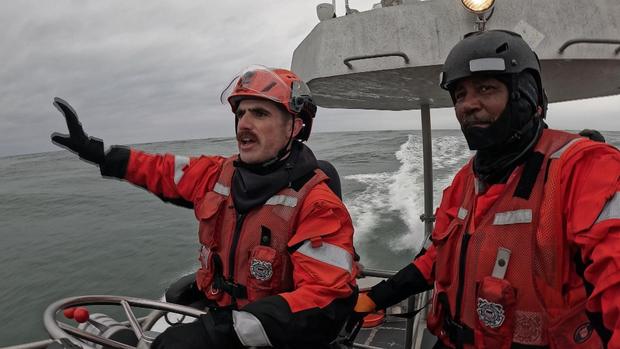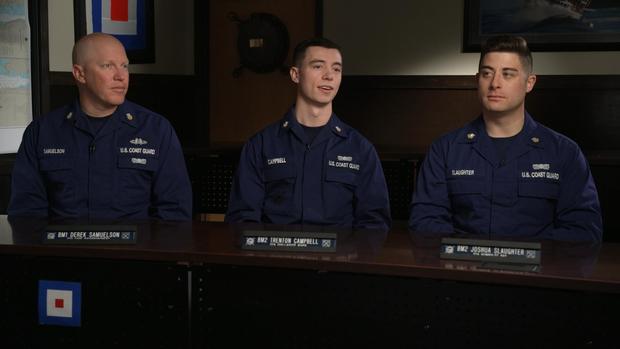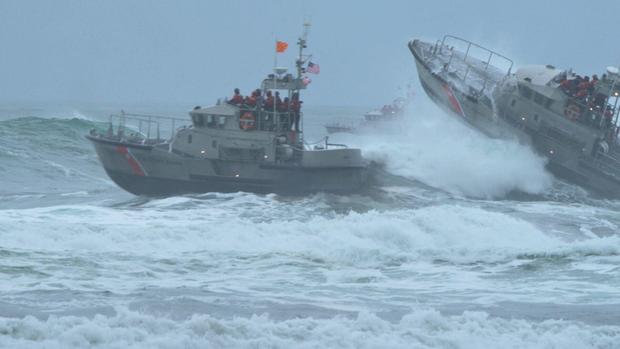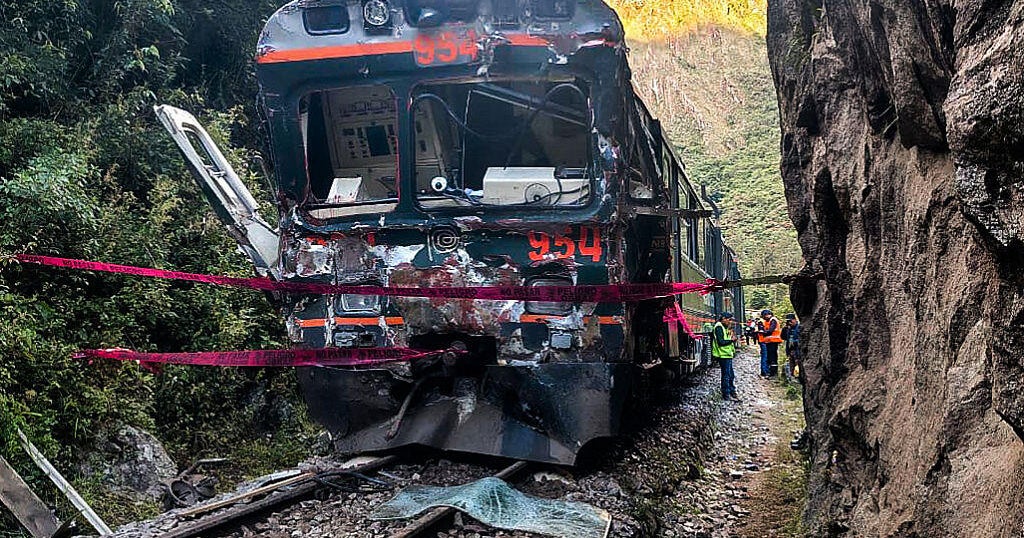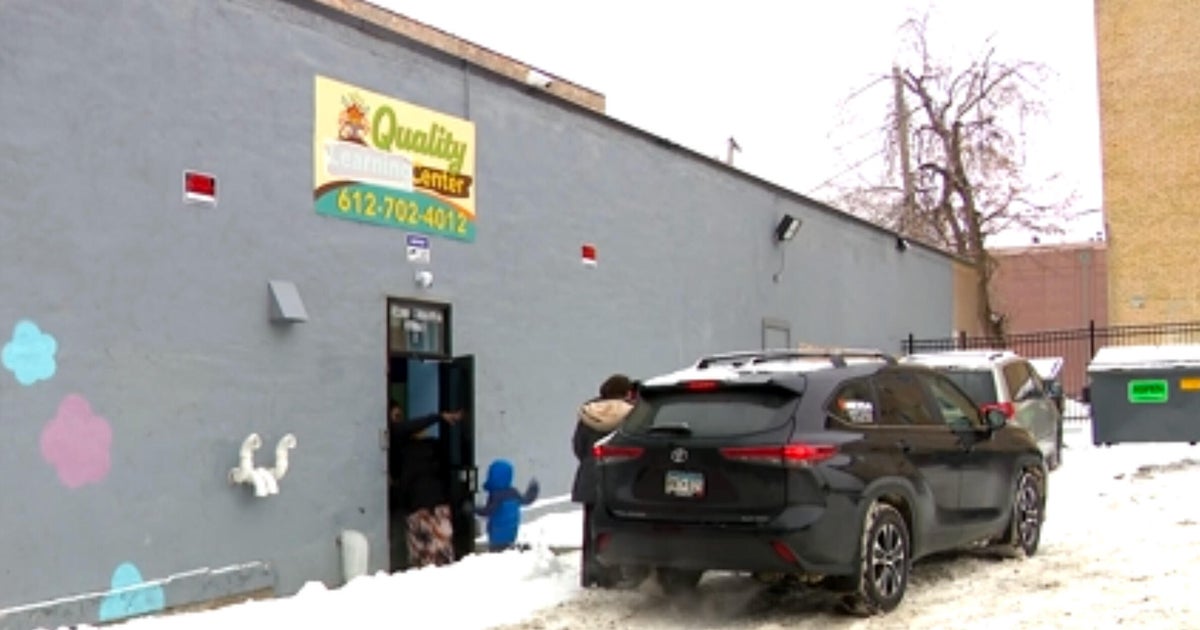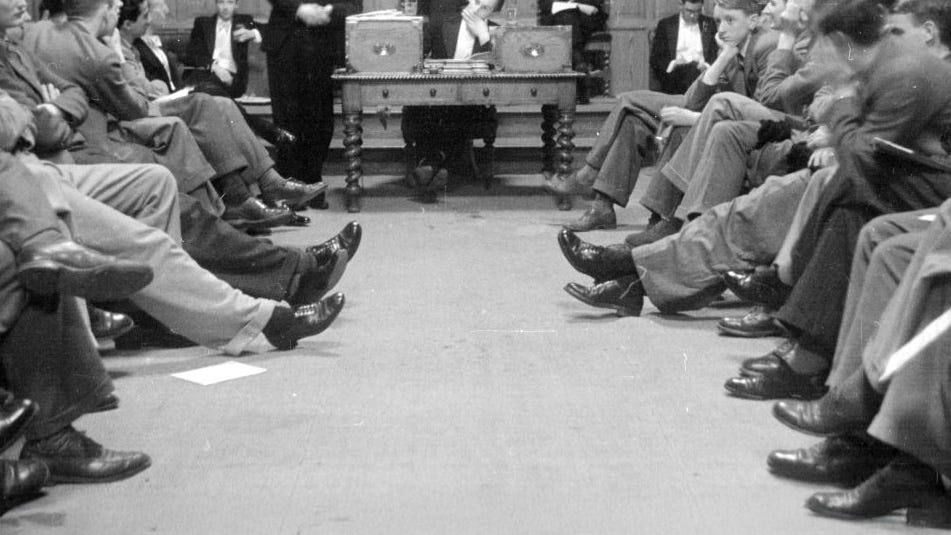U.S. Coast Guard trains elite rescuers in dangerous area called "Graveyard of the Pacific"
This is an updated version of a story first published on Oct. 27, 2024. The original video can be viewed here.
The spot where the Columbia River spills into the Pacific Ocean at the border between Oregon and Washington state is where Lewis and Clark ended their journey of discovery in 1805, with Clark writing in his journal "ocean in view! oh joy!"
But it's not all joy; in fact, it's one of the most dangerous inlets in America. Up to a million cubic feet of water can pour out of the river's mouth every second, and run right into waves that have been moving across the Pacific for thousands of miles.
As we first reported last fall, it's precisely because of this powerful aquatic collision that elite members of the United States Coast Guard come to this place once each year, determined to earn the coveted certification as surfmen.
Chief Eric Ceallaigh: On the bow.
Bill Whitaker: Here comes a big one.
Chief Eric Ceallaigh: Watch your head. Come to starboard.
On a wet February afternoon, we're on board a 47 foot U.S. Coast Guard motor lifeboat with Chief Eric Ceallaigh at the helm, driving through breaking surf barely a hundred yards off the beach.
Chief Eric Ceallaigh: I have another swell right up here.
Bill Whitaker: And another one right behind that.
Chief Eric Ceallaigh: Exactly.
At the time, Ceallaigh was chief instructor at the Coast Guard's national Motor Lifeboat School. This was the first day of "class," and the three students on his boat were studying his every turn of the wheel, and calling out approaching swells.
Trenton Campbell: You got a saddle, starboard bow.
Dillon: Here we go, here we go, Oh!
Six more trainees were on two other boats with other instructors. Ceallaigh says everyone is here because this place, at the mouth of the Columbia River, consistently has some of the worst weather and highest seas in America.
Chief Eric Ceallaigh: We expose them to a tremendous amount of surf conditions over 4 weeks. More so than they'd get over years out in their own unit.
Commander Tim Crochet: Morning shipmates. How are we?
First thing that morning, Tim Crochet, commanding officer of the Lifeboat School, had welcomed this class of nine students.
Commander Tim Crochet: And I promise you the instructors behind me are going to give you world class instruction, and they're gonna help you become a better motor lifeboat operator, and we're going to get you closer and closer to certifying as a surfman.
"Certifying as surfmen." That's the goal of each of these students, and the dream of thousands of other members of the Coast Guard.
Bill Whitaker: Being a Surfman is sometimes compared to being a Navy SEAL or in the Army Special Forces. But in truth, this is a more exclusive club, isn't it?
Commander Tim Crochet: Currently we have about 130 active duty Surfmen right now–
Bill Whitaker: Out of how many members of the Coast Guard?
Commander Tim Crochet: I think the Coast Guard's right around 40,000 people.
Bill Whitaker: 40,000 people and 100 Surfmen. So that is a pretty exclusive club.
Commander Tim Crochet: It is. There's a small number of us.
Certifying as a surfman means the Coast Guard trusts you to drive a lifeboat on the most challenging rescue missions: in 20-foot breaking waves and 50 knot winds. At the entrance to the school is a display of every surfman medallion – called a "check" – ever earned.
Bill Whitaker: So how far back does this go?
Commander Tim Crochet: It goes back to 1872.
That's when the U.S. Lifesaving Service began saving mariners in distress. It became the Coast Guard in 1915…and now operates 20 "surf stations" where rescues may have to be made in breaking waves. On average, the Coast Guard makes more than 5,000 rescues a year.
Bill Whitaker: Where is yours?
Commander Tim Crochet: Mine is right back here. It's check number 407.
Chief instructor Eric Ceallaigh – whose boat we were on - wears his surfman number.
Bill Whitaker: I understand you have a tattoo.
Chief Eric Ceallaigh: I do. I do. I-- I have my surfman number. I'm Surfman 545.
Chief Eric Ceallaigh: This is something that's very very important to me.
At the opening session of the Motor Lifeboat School, Chief Ceallaigh read the Coast Guard's "Surfman's Creed" aloud…
Chief Eric Ceallaigh: I will never unnecessarily jeopardize myself, my boat, or my crew, but will do so freely to rescue those in peril.
…and he told the students they'd each need to have the creed memorized before the four-week course was over.
Chief Eric Ceallaigh: It takes a lot to get there. It takes-- a person-- a special type person, willing to put themselves into those situations to where you're lookin' up at a 20-foot breakin' sea, and you're like, "I want to do this. I want to keep trainin' in this." (laugh)
This class was all male, but there are nearly a dozen female surfmen. Most candidates come here first for a basic course, then heavy weather, and finally this surf class. Derek Samuelson, Trenton Campbell, and Joshua Slaughter are the three trainees on Eric Ceallaigh's boat.
Derek Samuelson: Most of us are gonna be pushin' pretty close to four years when we get certified. That's almost a college degree worth of training in driving these boats.
Joshua Slaughter: It's somethin' not a lotta people get to do.
Bill Whitaker: Not that they get to do it, but that they achieve it.
Joshua Slaughter: That they achieve it, yes.
Trenton Campbell: We come here, our only job is to learn and drive in the surf. So it's-- it's a great opportunity.
Jeff Smith: This is a representation of the mouth of the Columbia.
Jeff Smith is the curator of the Columbia River Maritime Museum, which has a giant map illustrating how the mouth of the Columbia River has earned the title "graveyard of the Pacific."
Jeff Smith: All these little boats that you see are representative of the shipwrecks that have occurred.
Bill Whitaker: All of these. Over what period of time?
Jeff Smith: Yeah. We have 50 of them numbered, but there's many many more.
Thousands more, over several centuries, with at least 700 lives lost. The skeletons of wrecked ships still litter some area beaches.
Bill Whitaker: So despite how treacherous this waterway is, it's a vital economic waterway, as well.
Jeff Smith: It certainly is. Of all the grain exported from the United States, just over 40% goes out the Columbia River.
Every commercial ship coming into the river must have a local pilot come on board to guide it. This video shows how perilous it can be just to get that pilot onto one of those ships. Imagine the dangers faced by Coast guardsmen trying to rescue a ship or sailboat or fishing boat that's in trouble.
Jeff Smith: I'm always a little bit, I don't know if starstruck is the word or awestruck, when I'm in the presence of the men and women of our Coast Guard. Cause the job they do is just amazing. It's incredible. They're an incredible group of people.
Chief Eric Ceallaigh: It's such a cool mission that we get to do, like we get to go drive these awesome boats out and have the opportunity to save people on their darkest day.
As he drove into ever-stormier seas on that first day of school, it was clear Eric Ceallaigh would rather be at the helm of his lifeboat than just about anywhere else.
Bill Whitaker: So you love this, huh?
Chief Eric Ceallaigh: I absolutely love this.
But Ceallaigh was also deadly serious about teaching his students how to read every swell.
Chief Eric Ceallaigh: Watch that. Run from that. Running running running. You got that beat. Got a window right here, nice little near side shoulder. Easing off, let that come to me, I'm gonna get right on the back. Pull. Follow that key point. This is gonna get super dynamic down here, cause they're shooting in every direction.
When he couldn't outrun a wave, Ceallaigh executed what may be the most important maneuver a lifeboat driver must master.
Chief Eric Ceallaigh: Nowhere to go. Squaring up.
Squaring up is pointing the bow of the boat directly into and through a breaking wave…sometimes a really big breaking wave.
Bill Whitaker: We hit a couple of those yesterday where we got the spray--
Chief Eric Ceallaigh: Absolutely--
Bill Whitaker: --and we went up, and it-- you know, the-- the bow was up and you saw blue sky, (laugh) and then all of a sudden you-- you're down in a-- in a hole. What's the worst thing you could do in a situation like that?
Chief Eric Ceallaigh: The worst thing you could do is not be square to that breaking wave. You could have a knock down, which is when the boat goes underneath the water, but re-rights in the same direction. Or even worse, a 360° rollover.
Bill Whitaker: Uh-huh (affirm). Have you ever experienced that yourself?
Chief Eric Ceallaigh: I haven't experienced the full 360° rollover. I have experienced a-- a knockdown or two. And that's what they designed this boat for.
That design is seen in this demonstration video, but out in the surf, Eric Seallaigh was showing his students how to avoid ever having to test it on a real mission.
Bill Whitaker: How long before you let the students take control of the boat?
Chief Eric Ceallaigh: So starting tomorrow we'll do another demonstration of wherever we're gonna train, and then students are on it for the remainder of the course. Hold on.
Bill Whitaker: Whoa.
Every day for the next four weeks, the students took the helm, with Eric Ceallaigh signaling approval when they did something right, and correcting them when they didn't.
Chief Eric Ceallaigh: You probably should have squared up to that one. But -- on the bow, guys. (splash)
Students drove in every kind of condition, and ran simulated missions like pulling someone – in this case, a dummy - out of the water.
Trenton Campbell: Nice reach, Josh! Get him on board. Alright, stand by to clear the recess!
Sometimes a real rescue mission can supplant the simulations, as when the boats were making one last training run on graduation day 2023.
Chief Eric Ceallaigh: Sure enough, we heard a mayday-- for distress go out over channel 1-6, the radio frequency.
Mayday call: "I think I might be taking on water. Hurry up."
By the time the three training boats spotted a white boat called the Sandpiper, with one man on board, conditions had gone from mild to mad.
Chief Eric Ceallaigh: At this point, we're facing 25, 30-foot, 35-foot breaking seas. Fifty knots of winds. It's raining, hailing. And-- very, very dynamic.
Far too dynamic to have any chance of towing the vessel to safety. It was also graduation day for the Coast Guard's advanced rescue helicopter school, and they dropped a rescue swimmer named John Walton into the water. You can see him paddling furiously.
Chief Eric Ceallaigh: It was his first rescue. And they deployed him. And he was able to retrieve that individual off the Sandpiper right as that 30-foot-plus foot break rolled that boat multiple times.
It's hard to imagine how either the rescued or the rescuer survived that, but they both did.
Chief Eric Ceallaigh: But really, seeing how the Coast Guard worked together and have one of the-- the coolest rescues I've had in my entire career--
Bill Whitaker: On graduation day--
Chief Eric Ceallaigh: On graduation day for these future-- surfmen.
Graduation day for the class of 2024 was far more placid. All nine students completed the course, and all nine had memorized the surfman's creed.
Dorian Casey: I will, to the best of my ability, pursue each mission with the commitment, compassion, and courage inherent in the title surfman.
They didn't all certify as surfmen that day; most had to wait to return to their home units for their commanding officers to give them the nod. But two of the nine got a surprise.
Commander Tim Crochet: BM2 Casey, BM2 Campbell, front and center please.
Dorian Casey and Trenton Campbell had their commanding officers in attendance, ready to bestow the honor then and there.
It seemed every certified surfman on the West Coast had come, and they handed the coveted medallions – those "checks" – to one another…
Surfmen: Surfman 494, Station Quillayute River. 485, Station Morro Bay. 484, Station Humboldt Bay, 450, Station Quillayute River, 407 Station Chetco River.
…and then to the two newest surfmen. Trenton Campbell accepted hugs from his trainers and fellow classmates. And then headed back to his base, Station Quillayute River on the coast of Washington, ready to do what he joined the Coast Guard to do.
Trenton Campbell: The reason why we all want to be here is that dream to save a life. I think there's no better feeling than that. We're training for the opportunity to save a human life. It's all the motivation you need.
Produced by Rome Hartman. Associate producer, Sara Kuzmarov. Broadcast associate, Mariah B. Campbell. Edited by Aisha Crespo.

